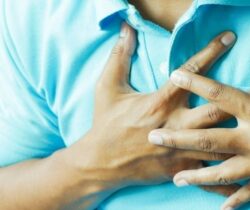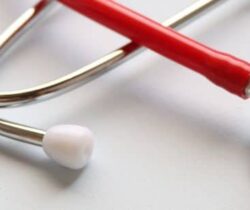Stroke is a significant health issue. According to the Australian Institute of Health and Welfare, more than a hundred strokes are estimated to have occurred here every day in 2020. In 2021, stroke caused around 67,900 hospitalisations and was the underlying cause of 8,500 deaths.
Fortunately, there are simple daily habits that can significantly reduce the risks for stroke.
In this article, we’ll examine those habits.
Understanding stroke
Stroke occurs when a blood vessel supplying blood to the brain either suddenly becomes blocked (an ischaemic stroke) or ruptures and bleeds (a haemorrhagic stroke). Either can result in part of the brain dying, leading to impairment that can affect a range of activities.
Haemorrhagic strokes are caused by abnormal changes in the blood vessels in the brain such as the development of an aneurysm (a swelling in a blood vessel wall), while ischaemic strokes are usually related to high blood pressure and heart disease.
The role of lifestyle in stroke prevention
A stroke can have serious and lasting effects, such as difficulty walking, inability to speak clearly or paralysis on one side of the body.
Most strokes are caused by a combination of risk factors that include:
- smoking
- high blood pressure
- having had a transient ischaemic attack (or TIA, also known as a ‘mini stroke’)
- atrial fibrillation
- diabetes
- high cholesterol
- doing insufficient physical activity
- living in a larger body size.
Many of these risk factors are modifiable (they can be managed and changed), and making healthy lifestyle choices can significantly reduce them. One such choice would be to eat more healthily.
Nutrition for stroke prevention
Healthy eating can help to prevent stroke. The Australian Stroke Foundation recommends:
- Having a variety of foods from the following five groups every day:
- vegetables of different types and colours, as well as legumes and beans
- fruit
- grain (cereal) foods—mostly wholegrain and high-fibre varieties such as breads, cereals, rice, pasta, noodles, polenta, couscous, oats, quinoa and barley
- lean meats and poultry, fish, eggs, tofu, nuts and seeds
- milk, yoghurt, cheese—mainly the reduced fat varieties.
- Limiting your intake of foods containing saturated fat, added salt and added sugars.
The Mediterranean diet and the DASH (Dietary Approaches to Stop Hypertension) Diet are two patterns of eating that may help prevent stroke. These diets encourage people to eat lots of vegetables, fruits and whole grains, which are high in antioxidants, vitamins, potassium, B vitamins and calcium.
Here are some practical tips for incorporating healthy eating habits into your daily life:
- Watch portion sizes—it’s important to be aware of how big your servings are, even with healthy food
- Plan your meals—this can help you avoid last-minute fast food choices or unhealthy snacks
- Cook and prepare your own meals—this gives you control over ingredients and portion sizes.
How can you reduce the risk of getting a stroke?
Physical activity and regular exercise
Making sure that you get enough exercise is important in combatting stroke risks. The Australian Government’s Department of Health and Aged Care recommends that adults should aim for at least 30 minutes of moderate-intensity physical activity such as brisk walking or cycling on most (preferably all) days of the week. It is also important to reduce and break up the time you spend sitting or lying down (except for when you’re sleeping).
Not doing enough physical activity is the second-biggest risk factor for stroke.
Here are some suggestions for ways to be more active in your daily life:
- Instead of driving or using public transport, walk or cycle to work; if you decide to take public transport, you could perhaps get off a stop early and walk the rest of the way
- Use the stairs as much as possible
- Exercise while watching TV or your phone
- Join a dance class, sports club or a gym
- Stand more—break up periods of sitting by standing up and stretching.
Maintaining a healthy weight
Maintaining a healthy weight is crucial in stroke prevention. Living in a larger body size can contribute to high blood pressure, type 2 diabetes, high cholesterol, heart disease, kidney disease and some cancers. These conditions increase the risk of stroke.
A healthy weight can be achieved and maintained by consistently making informed decisions about your diet, and by doing the recommended amount of exercise.
Mindful eating can help with body weight management. It involves paying close attention to the experience of eating, noticing how food makes you feel and the physical sensations it generates. Key aspects of mindful eating include:
- eating slowly, taking time to chew thoroughly and savour each bite
- listening to your body, paying attention to when you feel full (this can help avoid overeating)
- eating without distractions such as TV or phones. This allows you to focus on the food and your body’s response to it.
Blood pressure management
Blood pressure is the pressure of blood on the walls of the arteries as it is being pumped around the body. High blood pressure, which is a major risk factor for stroke, can be managed on a daily basis in the following ways:
- doing regular physical activity
- maintaining a healthy weight
- make healthy food choices, especially reducing your intake of sodium or salt
- limiting your alcohol consumption.
It is recommended that you manage your blood pressure in consultation with your healthcare provider.
Smoking cessation
Smoking doubles the risk of stroke. The good news is that when a person stops smoking, their blood pressure returns to normal within a month. Their risk of stroke and heart attack starts to fall immediately, and can drop by as much as a half after one year. After fifteen years, their risk of stroke and heart attack is almost the same as that of a person who has never smoked.
The Australian Government Department of Health and Aged Care provides resources to help you quit smoking. Call Quitline on 13 78 48 (13 QUIT) for support and advice.
Limiting alcohol intake
Alcohol can cause high blood pressure and contributes to being an unhealthy weight, both of which increase your risk of stroke. The Australian Guidelines suggest that to reduce the risk of harm from alcohol-related disease or injury, adults should have no more than ten standard drinks a week and no more than four standard drinks on any one day.
Stress management in stroke prevention
Managing stress is an important part of a healthy lifestyle. Long-term stress can lead to high blood pressure, as well as to behaviours that increase stroke risk such as unhealthy eating, physical inactivity, consuming too much alcohol and smoking.
Ways of managing stress include using:
- relaxation techniques such as controlled breathing, progressive muscle relaxation, mindfulness, meditation and yoga.
- behavioural management techniques, which help with recognising signs and sources of existing and potential stress or difficult situations.
- mindfulness apps such as The Smiling Mind
- online programs like MindSpot Clinic or THIS WAY UP (both are free).
Everyone’s experience with stress is different, and it’s important to find the management techniques that work best for you.
Good-quality sleep
Good-quality sleep is important for overall health; by contrast, poor-quality sleep can be a factor in the development of high blood pressure. Techniques for improving the quality of your sleep include maintaining a regular sleep schedule, creating a restful environment and avoiding caffeine and the use of phones and other electronic devices before bedtime.
Regular health check-ups
It is recommended that anyone aged 45 years and over, or 30 years and over for Aboriginal and Torres Strait Islander peoples, has a regular heart health check with their doctor. It’s a 20-minute check-up that assesses your risk of having a heart attack or stroke.
Regular check-ups are crucial in stroke prevention as they can help identify risk factors early on.
Conclusion
Stroke is a significant health concern in Australia. Fortunately, several of its risk factors can be positively influenced by living a healthy lifestyle. Living a healthy lifestyle is much easier if you have the right kind of support.
The Life! program provides this.
How the Life! program can help you
Life! is a free healthy lifestyle program that helps you improve your eating habits, increase your physical activity and manage stress. It will help you reduce your risk of developing stroke, heart disease and type 2 diabetes.
Life! is run by experienced health professionals, including dietitians and exercise physiologists, who guide and support you to make healthy lifestyle changes.
The program includes 7 sessions delivered over a 12-month period. You can choose from a group course or our telephone health coaching service. Learn more about the Life! program.
You can check your eligibility for the Life! program by taking a quick online test here.
Sources
Eat well – Stroke Foundation – Australia
Free, online, personalised mental health care with MindSpot – MindSpot
Online Mental Health Treatment Programs – THIS WAY UP
Australian Alcohol Guidelines revised – Australian Government Department of Health and Aged Care.
Australia’s Biggest Blood Pressure Check – Stroke Foundation.
Avoid alcohol – Stroke Foundation – Australia.
Eat well – Stroke Foundation – Australia.
Heart, stroke and vascular disease: Australian facts, High blood pressure.
High blood pressure – Australian Institute of Health and Welfare.
National Strategic Action Plan for Heart Disease and Stroke.
National Tobacco Campaign – Australian Government Department of Health and Aged Care.
Nutrition and Stroke – Nutrition Australia.
Physical activity and exercise guidelines for all Australians.
Quit smoking – Stroke Foundation – Australia.
Regular health checks – Better Health Channel.
Review of Cardiovascular Disease Programs – Department of Health and ….
Stay active – Stroke Foundation – Australia.
Stress – normal versus problematic, fight or flight – healthdirect.






